A rainscreen cladding system is an exterior wall detail that consists of an outer skin (the cladding) and an air cavity between this skin and the inner structure of the building. This system is designed to protect the building from weather elements while allowing for ventilation and drainage. Rainscreen cladding is becoming increasingly popular in modern architecture due to its aesthetic appeal and functional advantages.
What is the Purpose of a Rainscreen?
The primary purpose of a rainscreen is to manage moisture and prevent water infiltration into the building. Here’s how it works:
- Water Barrier: The outer cladding acts as the first line of defense against rainwater, diverting it away from the building.
- Ventilation: The air cavity behind the cladding allows for continuous airflow, which helps to evaporate any moisture that penetrates the cladding.
- Drainage: Any water that does get through the outer cladding can drain out through weep holes at the bottom of the cavity, ensuring it doesn’t accumulate and cause damage.
- Thermal Insulation: The system can also include thermal insulation, enhancing the building’s energy efficiency by reducing heat loss in the winter and heat gain in the summer.
What is the Difference Between a Rainscreen Wall and a Barrier Wall?
Understanding the distinction between a rainscreen wall and a barrier wall is crucial in appreciating the benefits of rainscreen cladding.
- Rainscreen Wall:
- Design: Consists of an outer cladding layer, an air cavity, and an inner weather-resistant barrier.
- Moisture Management: Designed to allow moisture to penetrate the outer layer but not the inner structure. The air cavity aids in ventilation and drainage.
- Performance: Provides superior protection against moisture by managing it effectively through ventilation and drainage systems.
- Barrier Wall:
- Design: Typically a single, solid wall without an air cavity.
- Moisture Management: Relies on the impermeability of the wall material to keep water out.
- Performance: Less effective in managing moisture, as any breach in the barrier can lead to water infiltration and potential damage over time.
Benefits of Installing a Rainscreen Cladding System
Installing a rainscreen cladding system offers numerous benefits, making it a preferred choice for many modern buildings:
- Enhanced Durability: By effectively managing moisture, rainscreen systems prevent water-related issues such as mold, mildew, and structural damage, thereby extending the lifespan of the building.
- Improved Energy Efficiency: The added layer of insulation and the air cavity help to regulate the building’s temperature, reducing the need for heating and cooling and lowering energy costs.
- Aesthetic Flexibility: Rainscreen cladding comes in various materials, colors, and textures, allowing architects to achieve diverse design aesthetics while maintaining functionality.
- Sustainable Building Practice: Many rainscreen systems use environmentally friendly materials and contribute to overall sustainability by enhancing the building’s energy efficiency.
- Maintenance and Repair: The modular nature of many cladding systems makes them easier to repair or replace, as individual panels can be accessed without disturbing the entire façade.
- Noise Reduction: The additional layers in the system can also help to reduce noise from outside, providing a more comfortable indoor environment.
The Increasing Popularity of Hardwood Rainscreen Cladding
In recent years, the use of hardwood rainscreen cladding has surged in popularity, becoming a go-to choice for architects, builders, and homeowners alike. Among the most favored hardwood species for rainscreen cladding are Ipe, Cumaru, Tigerwood, and Thermally Modified Wood.
These materials not only offer exceptional durability and aesthetics but also align with sustainable building practices. Let’s explore why these hardwood species are gaining traction and what makes them stand out.
Ipe

Ipe (pronounced “ee-pay”) is often heralded as the gold standard for hardwood cladding. Known for its remarkable hardness and proven lifespan up to 75 years, Ipe is an ideal choice for exterior applications.
- Durability: Ipe is incredibly dense and resistant to rot, decay, and insect damage. This durability ensures a long lifespan, even in harsh weather conditions.
- Aesthetics: With its rich, dark brown color and fine grain, Ipe offers a sophisticated and timeless appearance that complements various architectural styles.
- Maintenance: While Ipe requires minimal maintenance, its color can be preserved with occasional oil treatments to maintain its deep hue.
Cumaru

Cumaru, also known as Brazilian Teak, is another highly durable hardwood that is increasingly used for rainscreen cladding.
- Strength: Similar to Ipe, Cumaru is exceptionally hard and resistant to decay and insects, making it a robust choice for exterior cladding.
- Appearance: Cumaru boasts a warm, golden-brown color with interlocking grain patterns that add visual interest and elegance to any building façade.
- Longevity: This hardwood’s resistance to environmental stresses ensures it remains beautiful and functional for many years with minimal upkeep.
Tigerwood

Tigerwood is distinguished by its striking appearance, characterized by bold, contrasting stripes that give it a unique and exotic look.
- Visual Appeal: The dramatic, tiger-like stripes of Tigerwood make it a standout choice for those looking to make a design statement. Its natural luster adds to its visual appeal.
- Durability: Like other tropical hardwoods, Tigerwood is resistant to rot, decay, and insects, ensuring longevity and performance in various climates.
- Sustainability: Many sources of Tigerwood are managed sustainably, offering an eco-friendly option for conscientious builders and homeowners.
Thermally Modified Wood

Thermally Modified Wood undergoes a specialized heat treatment process that enhances its durability and stability, making it an excellent choice for rainscreen cladding.
- Stability: The thermal modification process reduces the wood’s tendency to warp, shrink, or swell, resulting in a highly stable material ideal for exterior use.
- Resistance: The treatment process also increases the wood’s resistance to decay and insect infestation, similar to that of naturally durable hardwoods.
- Sustainability: Thermally modified wood often uses locally sourced, less durable species, transforming them into high-performance materials, thus promoting sustainable forestry practices.
Why Hardwood Rainscreen Cladding?
The rise in popularity of hardwood rainscreen cladding can be attributed to several key factors:
- Natural Beauty: The rich colors and unique grain patterns of hardwoods add warmth and elegance to building exteriors, enhancing curb appeal and architectural interest.
- Durability and Longevity: The inherent strength and resistance to environmental factors ensure that hardwood cladding remains functional and attractive for many years, providing excellent value over time.
- Sustainability: Many hardwood species used for cladding are sourced from responsibly managed forests, and options like thermally modified wood promote sustainable practices by enhancing the durability of less durable species.
- Performance: Hardwood cladding systems are effective in managing moisture, improving insulation, and protecting the underlying structure, making them a practical choice for various climates.
Conclusion
Rainscreen cladding systems offer a sophisticated solution to the challenges of building durability, energy efficiency, and aesthetic design. By understanding the purpose and benefits of these systems, as well as the differences between rainscreen walls and barrier walls, building professionals and property owners can make informed decisions to enhance their structures’ performance and longevity.
